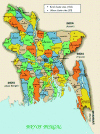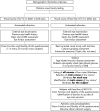Prevalence and causes of blindness and visual impairment in Bangladeshi adults: results of the National Blindness and Low Vision Survey of Bangladesh
- PMID: 12812875
- PMCID: PMC1771736
- DOI: 10.1136/bjo.87.7.820
Prevalence and causes of blindness and visual impairment in Bangladeshi adults: results of the National Blindness and Low Vision Survey of Bangladesh
Abstract
Aim: To determine the age, sex, and cause specific prevalences of blindness and visual impairment in adults 30 years of age and older in Bangladesh.
Methods: A nationally representative sample of 12 782 adults 30 years of age and older was selected based on multistage, cluster random sampling with probability proportional to size procedures. The breakdown of the cluster sites was proportional to the rural/urban distribution of the national population. The examination protocol consisted of an interview, visual acuity (VA) testing, autorefraction, and optic disc examination on all subjects. Corrected VA retesting, cataract grading, and a dilated fundal examination were performed on all visually impaired subjects. The definitions of blindness (<3/60) and low vision (<6/12 to >or=3/60) were based on the presenting visual acuity in the better eye. The World Health Organization/Prevention of Blindness proforma and its classification system for identifying the main cause of low vision and blindness for each examined subject was used.
Results: In total, 11 624 eligible subjects were examined (90.9% response rate) across the 154 cluster sites. A total of 162 people were bilaterally blind (1.53% age standardised prevalence) while a further 1608 subjects (13.8%) had low vision (<6/12 VA) binocularly. Visual acuity was >6/12 in the "better eye" in the remaining 9854 subjects (84.8%); however, 748 of these people had low vision in the fellow eye. The main causes of low vision were cataract (74.2%), refractive error (18.7%), and macular degeneration (1.9%). Cataract was the predominant cause (79.6%) of bilateral blindness followed by uncorrected aphakia (6.2%) and macular degeneration (3.1%).
Conclusions: There are an estimated 650 000 blind adults (95% CI 552 175 to 740 736) aged 30 and over in Bangladesh, the large majority of whom are suffering from operable cataract. This survey indicates the need for the development and implementation of a national plan for the delivery of effective eye care services, aimed principally at resolving the large cataract backlog and the inordinate burden of refractive error.
Figures





References
-
- World Health Organization. Programme for the Prevention of Blindness and Deafness. Global initiative for the elimination of avoidable blindness. Geneva: WHO, 1997:1–7.
-
- Limburg H, Vaidyathan K, Pampativar KN. Cataract blindness on the rise? Results of a door-to-door examination in Mohadi. Indian J Ophthalmol 1996;44:241–4. - PubMed
-
- Gupta SK. Prevalence and risk factors of cataract in India: a review. Dev Ophthalmol 1997;27:1–5. - PubMed
Publication types
MeSH terms
LinkOut - more resources
Full Text Sources
Medical
